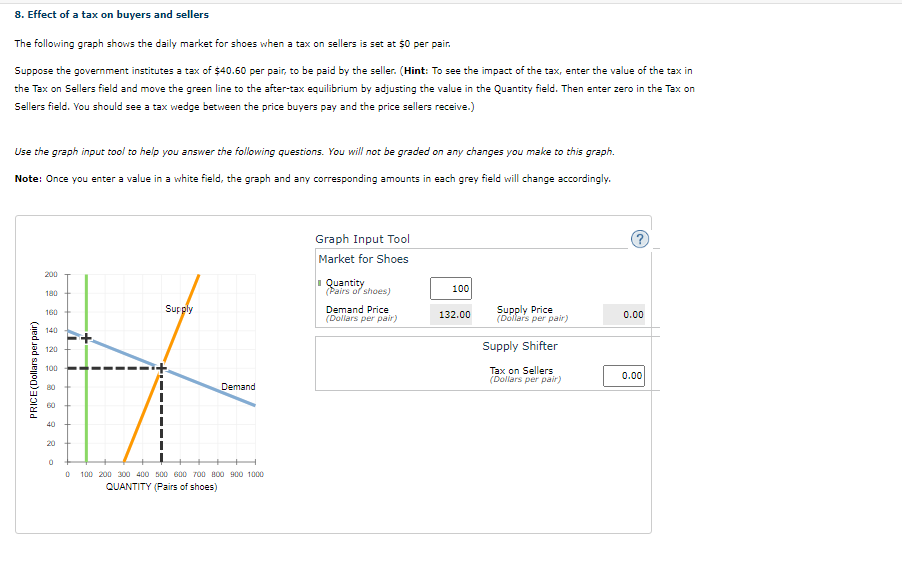Suppose the government institutes a tax of $40.60 per pair, to be paid by the seller. (Hint: To see the impact of the tax, enter the value of the tax in the Tax on Sellers field and move the green line to the after-tax equilibrium by adjusting the value in the Quantity field. Then enter zero in the Tax on Sellers field. You should see a tax wedge between the price buyers pay and the price sellers receive.) Use the graph input tool to help you answer the following questions. You will not be graded on any changes you make to this graph. Note: Once you enter a value in a white field, the graph and any corresponding amounts in each grey field will change accordingly. PRICE (Dollars per pair) 200 180 160 140 120 100 40 20 0 Supply Demand 0 100 200 300 400 500 600 700 800 900 1000 QUANTITY (Pairs of shoes) Graph Input Tool Market for Shoes Quantity (Pairs of shoes) Demand Price (Dollars per pair) 100 132.00 Supply Price (Dollars per pair) Supply Shifter Tax on Sellers (Dollars per pair) 0.00 0.00
Suppose the government institutes a tax of $40.60 per pair, to be paid by the seller. (Hint: To see the impact of the tax, enter the value of the tax in the Tax on Sellers field and move the green line to the after-tax equilibrium by adjusting the value in the Quantity field. Then enter zero in the Tax on Sellers field. You should see a tax wedge between the price buyers pay and the price sellers receive.) Use the graph input tool to help you answer the following questions. You will not be graded on any changes you make to this graph. Note: Once you enter a value in a white field, the graph and any corresponding amounts in each grey field will change accordingly. PRICE (Dollars per pair) 200 180 160 140 120 100 40 20 0 Supply Demand 0 100 200 300 400 500 600 700 800 900 1000 QUANTITY (Pairs of shoes) Graph Input Tool Market for Shoes Quantity (Pairs of shoes) Demand Price (Dollars per pair) 100 132.00 Supply Price (Dollars per pair) Supply Shifter Tax on Sellers (Dollars per pair) 0.00 0.00
Principles of Economics 2e
2nd Edition
ISBN:9781947172364
Author:Steven A. Greenlaw; David Shapiro
Publisher:Steven A. Greenlaw; David Shapiro
Chapter22: Inflation
Section: Chapter Questions
Problem 20RQ: What is indexing?
Related questions
Question
macro question 8


Transcribed Image Text:8. Effect of a tax on buyers and sellers
The following graph shows the daily market for shoes when a tax on sellers is set at $0 per pair.
Suppose the government institutes a tax of $40.60 per pair, to be paid by the seller. (Hint: To see the impact of the tax, enter the value of the tax in
the Tax on Sellers field and move the green line to the after-tax equilibrium by adjusting the value in the Quantity field. Then enter zero in the Tax on
Sellers field. Vou should see a tax wedge between the price buyers pay and the price sellers receive.)
Use the graph input tool to help you answer the following questions. You will not be graded on any changes you make to this graph.
Note: Once you enter a value in a white field, the graph and any corresponding amounts in each grey field will change accordingly.
Graph Input Tool
Market for Shoes
200
I Quantity
(Pairs of shoes)
100
180
Sup ply
Demand Price
(Dollars per pair)
Supply Price
(Dollars per pair)
160
132.00
0.00
140
Supply Shifter
120
Tax on Sellers
(Dollars per pair)
100
0.00
80
Demand
60
40
20
O 100 200 300 400 s00 600 700 B00 900 1000
QUANTITY (Pairs of shoes)
PRICE(Dollars per pair)
Expert Solution
This question has been solved!
Explore an expertly crafted, step-by-step solution for a thorough understanding of key concepts.
This is a popular solution!
Trending now
This is a popular solution!
Step by step
Solved in 2 steps

Knowledge Booster
Learn more about
Need a deep-dive on the concept behind this application? Look no further. Learn more about this topic, economics and related others by exploring similar questions and additional content below.Recommended textbooks for you

Principles of Economics 2e
Economics
ISBN:
9781947172364
Author:
Steven A. Greenlaw; David Shapiro
Publisher:
OpenStax

Economics Today and Tomorrow, Student Edition
Economics
ISBN:
9780078747663
Author:
McGraw-Hill
Publisher:
Glencoe/McGraw-Hill School Pub Co

Principles of Economics 2e
Economics
ISBN:
9781947172364
Author:
Steven A. Greenlaw; David Shapiro
Publisher:
OpenStax

Economics Today and Tomorrow, Student Edition
Economics
ISBN:
9780078747663
Author:
McGraw-Hill
Publisher:
Glencoe/McGraw-Hill School Pub Co